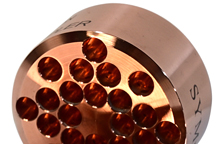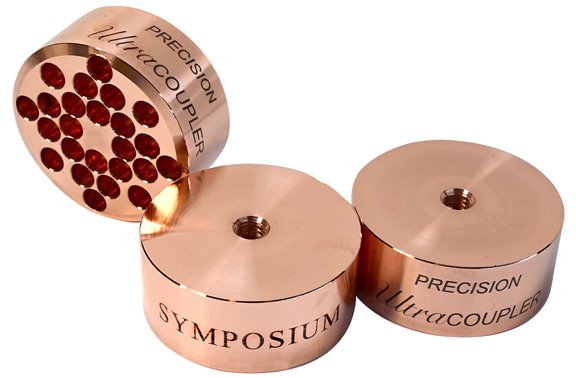Why Use Copper?
Much of the technology model of Symposium Acoustics products is based upon the physics of wave transmission; as opposed to simply isolation, we recognized long ago that comprehensive vibration control involved not merely isolation, but also the damping or drainage of mechanical energy (vibration) out of components (please see the Our Technology section for more detail). Vibration is waves of mechanical energy, similar to heat energy, and propagates through media of solid materials somewhat like electricity flows through electrical conductors. The speed and efficiency with which vibration can travel through its media have to do with the properties of the media itself. Like electricity flowing through a conductor, vibration will encounter greater or lesser resistance (as well as other properties) when flowing through matter depending upon the characteristics of the material. Foremost among these characteristics is propagation speed and resistance. As with electrical conductors, there are better and worse conductors of mechanical current, and the characteristics of mechanical transmission are, interestingly, analogous to those of electrical conductivity. The best conductors of electricity are also the best conductors of mechanical energy. A silver spoon will heat up much faster when put into hot water than a spoon made of, for instance, stainless steel, because silver is much more efficient conductor of heat or vibratory energy than steel.
The four best conductors of either electrical or mechanical energy in nature, at normal room temperatures (we're not talking about superconductors operating near absolute zero!) are, in order, Silver, Copper, Gold, and Aluminum. All other metals are below these, the "big four." Pure Silver is the best conductor, period, but impractical for our purposes in audio except where relatively small amounts of it are used (such as in plating operations or when used as wire conductors). But close behind silver is copper. Copper is much less expensive and can be made into various alloys for purposes of strength, such as Tellurium Copper, etc (which is the material used in our Tellurium Copper reversible spikes in our rack systems for similar reasons of mechanical efficiency in conducting vibration out of the rack). So, when it came to coupling two surfaces together in order to ensure efficient transmission of mechanical energy for the purpose of vibration control, copper was a "no-brainer."
The Osiris Ultimate rack system
The Symposium Osiris Rack (the Ultimate model pictured at the top of the Osiris page) uses solid OFC (oxygen-free) copper for its frame system, because the frame of a Symposium rack system is seen and treated as a mechanical ground system, or "lightning rod" for excess vibration which we want to evacuate from the rack and its shelves. The faster and more efficiently this can be done, the better the sonic results. Bass, dynamics, musicality, and virtually all the positive aspects of an audio system which enhance sound quality due to the absence or reduction of mechanical noise (vibration) will benefit. So it is with the UltraCoupler, which uses pure oxygen-free copper, the best electrical conductor next to pure silver, as its medium.

The Matrix
The bottom of the Precision Supercoupler has a "matrix" pattern of holes, along with beveled edging. As in the Series 2 Rollerblock, this "matrix" serves both as a waveguide which enhances the penetration of mechanical energy into the support surface by presenting a more optimal angle interface (see the "Our Technology" section", but also increases contact pressure to the supporting surface, affecting superior energy transmission. This feature, part of the original patent of the Series 2 Rollerblock, is an effective and important enhancement to the coupling efficiency of footer devices for the purpose of improving mechanical transmission.
The Threaded 1/4-20 hole
Like the Precision Coupler, SuperCouplers, Rollerblock Jr. and Rollerblock HDSE, the top of the UltraCoupler has a hole threaded for a 1/4-20 thread, which is a very common thread for many posts and equipment feet. This hole, dead center, can serve several purposes: it allows threading to dedicated posts or anchors; it allows screwing two UltraCouplers together (or to Rollerblock Jr., which have the same thread) for special coupling applications needing added height; or, the hole can be used as a receptacle for the tips of spikes and cones under racks and stands. In this last regard the UltraCoupler makes an ideal floor protector, since it not only protects floors but also provides an unsurpassed "termination" for vibratory energy exiting a rack or stand through its bottom spikes.
Deployment
UltraCouplers should be used like any footer device, to make a "bridge" between the bare chassis of the component and its mechanical ground, i.e. the shelf, platform, etc. Positioning of the UltraCoupler (as with any footer device) on the platform can make subtle yet important changes in sonic results, owing to the interplay of the mechanical resonances of the platform's surface. Experimentation is, as with all Symposium products, recommended and encouraged.


